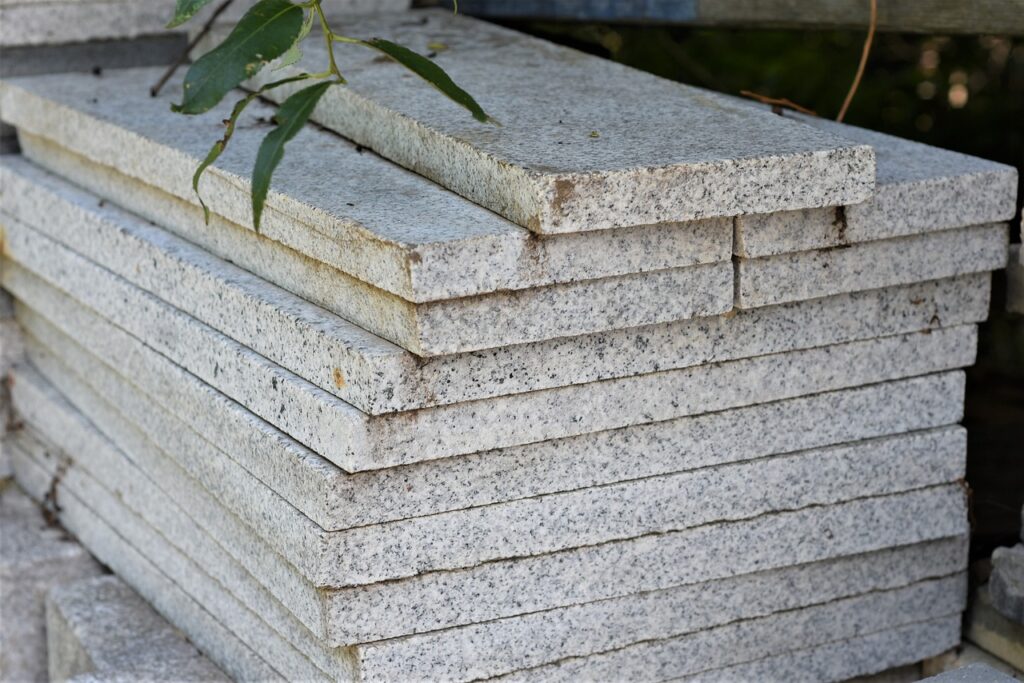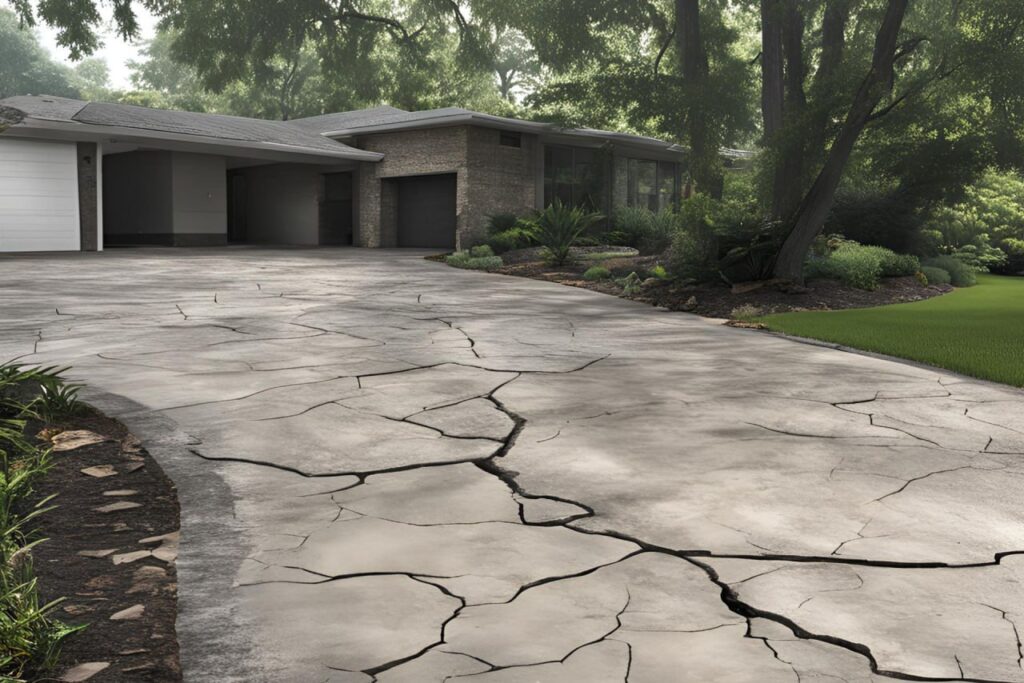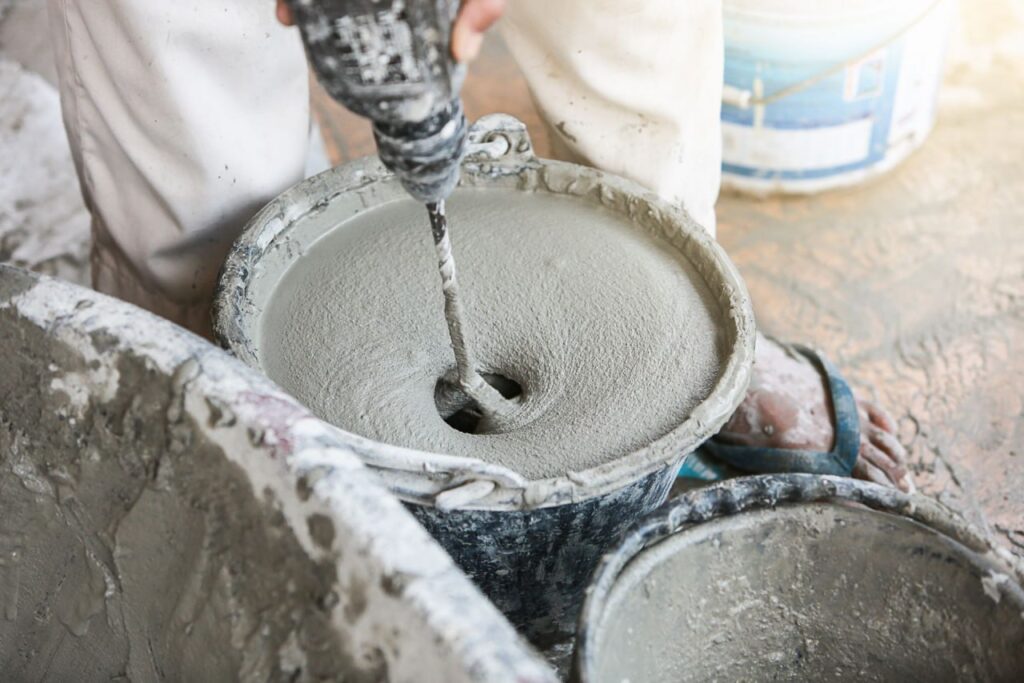Welcome to our comprehensive guide on understanding the crucial chemical processes that give concrete its remarkable strength and durability. In this post, we’ll delve into the fascinating world of concrete hardening, focusing on the key chemical Calcium Silicate Hydrate (CSH) that plays a vital role in transforming a simple mix of water, cement, and aggregates into the sturdy, reliable material that underpins so much of our modern infrastructure. Whether you’re a curious homeowner, an aspiring DIY enthusiast, or a seasoned construction professional, this guide will equip you with essential knowledge about the hardening process, the role of various chemicals, and best practices for ensuring your concrete projects stand the test of time.
The primary chemical used to harden concrete is Calcium Silicate Hydrate (CSH). Formed during the hydration process, CSH is essential in giving concrete strength and durability. This chemical reaction occurs when water interacts with cement, leading to the formation of CSH, which binds the aggregate materials together, creating a solid and sturdy structure.
- Understanding Concrete Hardening
- The Primary Chemical Used: Calcium Silicate Hydrate (CSH)
- The Chemistry Behind Concrete Hardening
- Other Chemicals That Contribute To Concrete Hardening
- Admixtures And Their Role In Concrete Hardening
- The Impact Of Environmental Factors
- Innovations In Concrete Hardening Chemicals
- Practical Tips For Ensuring Proper Concrete Hardening
- FAQs: About What Chemical Is Used To Harden Concrete
- Conclusion
- Find A Professional Concrete Company Near You!
Understanding Concrete Hardening
Concrete hardening is a fundamental aspect of construction, ensuring that structures attain the necessary strength and durability. The process begins with curing, a critical phase in the life cycle of concrete. Curing involves maintaining adequate moisture, temperature, and time to allow the concrete to achieve its desired properties.
When water is added to cement, a chemical reaction called hydration occurs. This reaction is responsible for the hardening and setting of the concrete. During hydration, the cement particles react with water, forming a paste that binds the aggregates together. This process is exothermic, meaning it releases heat, which is why you might feel warmth when touching freshly poured concrete.
The curing process ensures that the concrete remains moist by preventing the rapid evaporation of water. This is vital because if the concrete dries out too quickly, the hydration process is interrupted, leading to insufficient strength and durability. There are several methods to cure concrete, including:
1. Water Curing: This method involves keeping the concrete surface continuously wet. Techniques include ponding, spraying, or covering the surface with wet burlap or cotton mats.
2. Sealing: Applying a curing compound or plastic sheeting to the surface to retain moisture.
3. Steam Curing: Commonly used in precast concrete, steam provides the necessary heat and moisture for the curing process.
Proper curing is crucial for the development of the concrete’s microstructure, which ultimately determines its strength and durability.
Importance of Proper Hardening for the Durability and Strength of Concrete Structures
The importance of proper hardening cannot be overstated when it comes to the longevity and resilience of concrete structures. Properly cured concrete will:
- Achieve Maximum Strength: Concrete continues to gain strength over time as the hydration process progresses. Proper curing ensures that this process is uninterrupted, allowing the concrete to reach its full potential in terms of compressive strength. This is particularly important for load-bearing structures where strength is a critical factor.
- Enhance Durability: Well-cured concrete is more resistant to various forms of deterioration. Proper curing minimizes the development of cracks, which can occur due to shrinkage if the concrete dries too quickly. These cracks can lead to further damage over time as they provide pathways for water and other harmful substances to penetrate the concrete.
- Improve Surface Hardness: The surface of the concrete benefits significantly from adequate curing. It becomes more resistant to abrasion and wear, making it suitable for high-traffic areas. This is essential for applications like pavements, driveways, and industrial floors.
- Increase Resistance to Environmental Factors: Properly hardened concrete is more resilient to environmental stressors such as freeze-thaw cycles, chemical attacks, and thermal variations. This ensures that structures remain intact and functional over a longer period, even in harsh conditions.
- Reduce Maintenance Costs: Structures made with well-cured concrete require less maintenance and have a longer service life. This translates to cost savings over time, as there is less need for repairs and replacements.
In conclusion, understanding and implementing the concrete curing process is essential for any construction project. Ensuring proper hardening not only maximizes the strength and durability of the concrete but also enhances the overall performance and longevity of the structure. By paying close attention to this critical phase, builders and engineers can deliver high-quality, resilient concrete structures that stand the test of time.

The Primary Chemical Used: Calcium Silicate Hydrate (CSH)
Introduction to Calcium Silicate Hydrate
Calcium Silicate Hydrate, commonly known as CSH, is the cornerstone of concrete’s structure. As the principal binder in cement paste, CSH forms the matrix that holds concrete together, providing it with strength and durability. This compound is crucial in the construction industry due to its unique properties that significantly contribute to the overall performance of concrete.
Explanation of How CSH Forms During the Hydration Process
The formation of CSH is a fascinating chemical process that occurs during the hydration of cement. When water is added to cement, it reacts with the calcium silicates (primarily tricalcium silicate and dicalcium silicate) present in the cement. This reaction, known as hydration, produces calcium hydroxide and CSH as its primary products.
During hydration, CSH forms as a gel-like substance that gradually crystallizes, filling the spaces between cement particles and enveloping the aggregate particles within the concrete mix. This process leads to the development of a dense and interconnected microstructure, which is essential for the mechanical properties of concrete.
The Role of CSH in Giving Concrete Its Strength and Hardness
The significance of CSH in concrete cannot be overstated. It is the primary source of concrete’s strength and hardness. The intricate network of CSH crystals binds the components of concrete together, providing the material with its notable compressive strength. The formation of CSH creates a rigid framework that resists deformation and withstands substantial loads.
Moreover, CSH contributes to the long-term durability of concrete. Its dense structure limits the penetration of water and harmful chemicals, reducing the risk of corrosion in steel reinforcement and minimizing deterioration over time. This property is particularly crucial for concrete structures exposed to harsh environmental conditions.
In addition to its mechanical strength, CSH imparts concrete with a degree of toughness and resistance to cracking. The continuous hydration of cement leads to ongoing CSH formation, which helps heal microcracks within the concrete matrix, enhancing its overall integrity and lifespan.
In summary, Calcium Silicate Hydrate (CSH) is the fundamental chemical compound responsible for the robust properties of concrete. Through the hydration process, CSH forms a solid and cohesive matrix that provides concrete with its essential strength, hardness, and durability. Understanding the role of CSH is vital for appreciating how concrete can endure significant stresses and environmental challenges, making it one of the most reliable and widely used construction materials globally.

The Chemistry Behind Concrete Hardening
Overview of the Chemical Reaction During Concrete Curing (Hydration Process)
Concrete hardening is a fascinating process driven by chemistry. At its core is the hydration process, a series of chemical reactions between cement and water. When water is added to cement, it triggers a reaction that transforms the mixture from a pliable, moldable state into a solid, rock-like mass. This process, known as curing, is critical because it determines the concrete’s final strength and durability.
Detailed Explanation of the Role of Water, Cement, and Aggregates
- Water: Water is a crucial ingredient in the concrete mix. It initiates the hydration process, allowing the cement to react and bind the aggregates together. However, the amount of water must be carefully controlled. Too much water can weaken the concrete, while too little can hinder the hydration process, leading to incomplete curing and reduced strength.
- Cement: Cement acts as the binder in concrete. It consists of various compounds, primarily calcium silicates, which react with water during hydration. The most important reactions involve tricalcium silicate (C3S) and dicalcium silicate (C2S). These reactions produce calcium silicate hydrate (CSH) and calcium hydroxide (CH), both of which contribute to the concrete’s hardening and strength.
- Aggregates: Aggregates, such as sand, gravel, or crushed stone, provide the bulk and strength of the concrete. They occupy most of the volume and help reduce the shrinkage that occurs as the concrete dries and hardens. The interaction between cement paste and aggregates is essential for the formation of a solid, cohesive mass.
Formation of CSH and Its Significance in the Hardening Process
The formation of calcium silicate hydrate (CSH) is the cornerstone of concrete hardening. When water reacts with the silicates in cement, CSH is produced. This compound is a gel-like substance that fills the spaces between the aggregates and the cement particles. As the CSH gel forms and hardens, it binds the aggregates together, giving the concrete its strength and durability.
CSH formation can be described in two main stages:
1. Initial Setting: This occurs within the first few hours after water is added to the cement. During this stage, the mixture begins to stiffen as CSH starts to form. The concrete remains workable but begins to lose its plasticity.
2. Hardening: Over the next several days and weeks, the hydration process continues, and more CSH is produced. The concrete gradually gains strength and becomes harder as the CSH gel further binds the aggregates together.
The significance of CSH in the hardening process cannot be overstated. It is the primary contributor to the mechanical properties of concrete. The more CSH that forms, the stronger and more durable the concrete becomes. This is why controlling the curing conditions, such as maintaining adequate moisture and temperature, is crucial for achieving optimal concrete performance.
In conclusion, the chemistry behind concrete hardening is a complex interplay of water, cement, and aggregates, with the hydration process playing a pivotal role. Understanding this process is essential for producing high-quality concrete that meets the demands of modern construction.

Other Chemicals That Contribute To Concrete Hardening
In the world of concrete, the hardening process is a critical phase that determines the material’s strength and durability. While the water-cement ratio is a fundamental aspect, it’s not the only factor at play. Various other chemicals significantly contribute to the hardening of concrete, ensuring it achieves its desired properties. Two such vital compounds are Tricalcium Silicate (C3S) and Dicalcium Silicate (C2S).
Tricalcium Silicate (C3S)
Tricalcium Silicate, often abbreviated as C3S, is one of the primary compounds found in Portland cement. It plays a crucial role in the early stages of concrete hardening. When water is added to cement, C3S reacts rapidly, initiating the hydration process. This reaction is highly exothermic, releasing a substantial amount of heat. The resulting products are calcium silicate hydrate (C-S-H) and calcium hydroxide (Ca(OH)2).
Contribution to Early Strength
- Rapid Hydration: The fast reaction of C3S with water leads to the quick formation of C-S-H, which is the main binding agent that gives concrete its initial strength. This rapid hardening is particularly beneficial in construction projects where early strength is essential, such as in the construction of high-rise buildings and roadways.
- Heat Generation: The exothermic nature of the C3S hydration process helps in accelerating the curing process, especially in colder climates. This heat can be advantageous in preventing the concrete from freezing during the initial stages.
Dicalcium Silicate (C2S)
Dicalcium Silicate, known as C2S, also plays a significant role in the hardening process but in a different manner compared to C3S. The hydration reaction of C2S is slower and less exothermic, which means it contributes more to the long-term strength of concrete rather than the early strength.
Contribution to Long-term Strength
- Slow Hydration: The slower reaction rate of C2S with water means that the formation of C-S-H continues over a more extended period. This slow and steady process results in a gradual increase in the strength of the concrete over time.
- Reduced Heat: Since the hydration of C2S generates less heat, it is beneficial in mass concrete structures, where excessive heat could lead to cracking. The lower heat generation helps in maintaining the structural integrity of large concrete elements.
Interplay Between C3S and C2S
The combination of Tricalcium Silicate and Dicalcium Silicate in cement is essential for balancing both early and long-term strength of concrete. C3S ensures that the concrete gains enough strength quickly, which is crucial for the initial stages of construction. On the other hand, C2S provides a sustained strength gain, ensuring that the concrete remains durable and robust over its lifespan.
Understanding the roles of Tricalcium Silicate (C3S) and Dicalcium Silicate (C2S) in the hardening process of concrete helps in appreciating the complexity and science behind concrete’s strength. Their contributions are pivotal, with C3S being the key player in early strength development and C2S ensuring long-term durability. This intricate interplay of compounds is what makes concrete one of the most reliable and widely used construction materials in the world.
By delving into these chemical processes, one can better appreciate the importance of selecting the right type of cement and the correct mix ratios to achieve the desired performance for any construction project.

Admixtures And Their Role In Concrete Hardening
When it comes to concrete construction, achieving the perfect balance between workability, strength, and durability is essential. One of the key elements that help in achieving this balance is the use of chemical admixtures. These substances are added to concrete mixtures to enhance their properties, particularly during the hardening process. In this section, we will explore the different types of admixtures that play a crucial role in concrete hardening, including accelerators, retarders, and superplasticizers, and how they influence the curing process and the final properties of concrete.
Introduction to Chemical Admixtures
Chemical admixtures are ingredients other than water, aggregates, cement, and fibers that are added to the concrete mix immediately before or during mixing. These admixtures can modify the concrete’s properties to make it more suitable for specific conditions and requirements. They are used to improve concrete’s performance, control setting and hardening time, enhance durability, and achieve other desired characteristics.
Types of Admixtures That Enhance Concrete Hardening
There are several types of admixtures designed to specifically enhance the hardening of concrete. Among these, accelerators, retarders, and superplasticizers are the most commonly used.
Accelerators
Accelerators are admixtures that speed up the hardening process of concrete. They are particularly useful in cold weather conditions where the setting time of concrete is significantly delayed. By adding accelerators, the rate of hydration is increased, allowing concrete to gain strength more quickly. This can be beneficial for early-age strength development, reducing the time required for curing, and allowing for faster construction schedules. Common examples of accelerators include calcium chloride and sodium nitrate.
Retarders
Retarders, on the other hand, slow down the hardening process of concrete. This is particularly useful in hot weather conditions where concrete can set too quickly, leading to potential cracking and reduced workability. By delaying the setting time, retarders provide more time for mixing, transporting, and placing the concrete, ensuring a better finish and reducing the risk of cold joints. Common retarding admixtures include gypsum and sugar.
Superplasticizers
Superplasticizers, also known as high-range water reducers, are admixtures that enhance the flowability of concrete without increasing its water content. This allows for the production of high-strength concrete with lower water-cement ratios. Superplasticizers are particularly useful in creating self-consolidating concrete that can flow and fill forms without the need for mechanical vibration. They significantly improve the workability of concrete, making it easier to place and finish. Examples of superplasticizers include sulfonated melamine formaldehyde and polycarboxylate ethers.
How These Admixtures Affect the Curing Process and Final Properties of Concrete
The use of chemical admixtures can significantly impact the curing process and the final properties of concrete.
- Accelerators: shorten the curing time, allowing concrete to achieve its strength more quickly. This is particularly advantageous in projects where time is a critical factor. However, the use of accelerators must be carefully controlled to avoid excessive shrinkage and potential cracking.
- Retarders: extend the curing time, providing more flexibility in terms of mixing and placing the concrete. This ensures a more uniform and controlled hardening process, reducing the risk of premature setting and improving the overall quality of the concrete. However, if used excessively, retarders can lead to prolonged setting times, which might delay construction schedules.
- Superplasticizers: enhance the workability of concrete, making it easier to place and finish while maintaining a low water-cement ratio. This results in high-strength concrete with improved durability and resistance to environmental factors. Proper use of superplasticizers can lead to denser, more durable concrete structures that are less susceptible to cracking and other forms of damage.
In conclusion, chemical admixtures play a vital role in the hardening of concrete. By understanding the functions and benefits of accelerators, retarders, and superplasticizers, construction professionals can optimize the concrete curing process, achieving the desired strength and durability for various construction projects. The strategic use of these admixtures can significantly enhance the performance and longevity of concrete structures, making them more resilient and cost-effective in the long run.

The Impact Of Environmental Factors
When it comes to concrete hardening, environmental factors play a crucial role in determining the strength and durability of the final product. Understanding how temperature, humidity, and other environmental conditions affect concrete can help ensure optimal curing and long-lasting results.
Temperature and Concrete Hardening
Temperature significantly impacts the rate at which concrete hardens. In warmer climates, the chemical reaction between cement and water, known as hydration, accelerates. This means concrete sets and gains strength faster. However, if the temperature is too high, it can cause rapid evaporation of water, leading to insufficient hydration. This results in weaker concrete that is more prone to cracking and other defects.
In contrast, colder temperatures slow down the hydration process. If the temperature drops below freezing, the water in the concrete can freeze, causing expansion and potential damage to the structure. To counter these effects, it is essential to use proper insulation and heating techniques during the curing process in colder climates.
Humidity’s Role in Concrete Curing
Humidity levels also have a profound impact on concrete hardening. High humidity conditions can be beneficial as they reduce the rate of water evaporation from the concrete surface. This allows for better hydration and stronger concrete. However, excessive moisture can lead to surface defects and delayed curing times.
On the other hand, low humidity can cause rapid water loss, resulting in a weaker and more brittle concrete structure. To mitigate this, it is crucial to maintain adequate moisture levels during the curing process through techniques such as misting, using curing compounds, or covering the concrete with wet burlap or plastic sheets.
Best Practices for Curing Concrete in Various Environmental Conditions
To ensure concrete cures properly under different environmental conditions, here are some best practices:
Hot Weather Curing
- Use Cool Water: Mix concrete with cool water to lower the initial temperature.
- Shade the Concrete: Protect the concrete from direct sunlight to reduce surface temperature.
- Apply Evaporation Retardants: Use chemical agents that slow down water evaporation.
- Cure with Water: Keep the concrete surface moist by sprinkling water or using wet coverings.
Cold Weather Curing
- Insulate the Concrete: Use blankets, heated enclosures, or insulation to retain heat.
- Use Accelerators: Add accelerating admixtures to the mix to speed up the hydration process.
- Monitor Temperature: Keep the concrete at a temperature above 10°C (50°F) to prevent freezing.
- Gradual Cooling: Avoid rapid cooling of the concrete to prevent thermal shock.
Humid Conditions
- Cover the Concrete: Use impermeable covers to protect the surface from excessive moisture.
- Ventilation: Ensure proper air circulation to avoid condensation and mildew growth.
- Monitor Curing Time: Allow extra time for curing if the humidity levels are exceptionally high.
Dry Conditions
- Use Moist Curing Methods: Regularly wet the concrete surface to maintain moisture levels.
- Apply Curing Compounds: Use sealants or curing compounds that retain moisture within the concrete.
- Wind Barriers: Erect barriers to reduce wind exposure, which can accelerate water evaporation.
Understanding and adapting to the impact of environmental factors on concrete hardening is essential for achieving strong, durable structures. By following these best practices, you can ensure that your concrete projects withstand the test of time, regardless of the climate conditions they face.

Innovations In Concrete Hardening Chemicals
Introduction to New and Advanced Chemicals Used in Modern Concrete Technology
Concrete technology has evolved significantly over the past few decades, driven by the need for more durable, resilient, and sustainable construction materials. Among these advancements, the development and application of innovative concrete hardening chemicals have played a pivotal role. These chemicals are designed to enhance the properties of concrete, making it stronger, more durable, and better suited for various environmental conditions.
In the past, concrete hardening was primarily dependent on traditional materials and techniques. However, the introduction of advanced chemical additives has revolutionized the industry. These chemicals are formulated to improve the mechanical properties of concrete, accelerate curing times, and increase resistance to environmental stresses such as moisture, temperature fluctuations, and chemical exposure.
Examples of Innovative Products and Their Benefits
Several innovative products have emerged in the market, each offering unique benefits to the concrete construction industry. Here are a few notable examples:
- Nano-Silica Additives: Nano-silica is a highly reactive pozzolan that significantly enhances the strength and durability of concrete. By filling the microscopic voids within the concrete matrix, nano-silica improves the density and reduces permeability. This results in concrete that is less prone to cracking and more resistant to chemical attacks.
- Polycarboxylate Ether (PCE) Superplasticizers: PCE superplasticizers are high-range water reducers that enhance the workability of concrete without compromising its strength. These chemicals allow for the production of high-performance concrete with superior flow properties, making it easier to pump and place. Additionally, PCE superplasticizers reduce the water-cement ratio, leading to higher compressive strengths and improved durability.
- Calcium Sulfoaluminate (CSA) Cements: CSA cements are known for their rapid hardening properties and low shrinkage rates. These cements contain specialized chemical compounds that react quickly with water, allowing concrete to achieve high early strength. This is particularly beneficial for projects with tight schedules, such as road repairs and bridge construction.
- Self-Healing Concrete Additives: Self-healing concrete incorporates microcapsules filled with healing agents such as sodium silicate or bacteria. When cracks form, these capsules break open, releasing the healing agents that react with moisture to form a gel-like substance. This gel fills the cracks and prevents further damage, effectively extending the lifespan of the concrete structure.
Case Studies or Examples of Projects Using These Advanced Chemicals
Innovative concrete hardening chemicals have been successfully implemented in various high-profile projects worldwide. Here are a few examples:
- The Shanghai Tower, China: One of the tallest buildings in the world, the Shanghai Tower, utilized nano-silica additives in its concrete mix to achieve the required strength and durability. The use of these additives ensured that the structure could withstand the high wind loads and seismic activity common in the region.
- The Gotthard Base Tunnel, Switzerland: The longest and deepest railway tunnel in the world, the Gotthard Base Tunnel, incorporated PCE superplasticizers in its concrete. This allowed for the production of high-performance concrete that could be easily pumped over long distances and at great depths, ensuring the tunnel’s structural integrity.
- The Alila Villas, Bali: This luxury resort utilized self-healing concrete additives in its construction to ensure longevity and reduce maintenance costs. The self-healing properties of the concrete were particularly beneficial in the humid, tropical climate of Bali, where traditional concrete would be more prone to cracking and deterioration.
- The Grand Paris Express, France: This large-scale metro project used CSA cements to expedite the construction process. The rapid hardening properties of CSA cement allowed for faster setting times, enabling the project to stay on schedule and reduce overall construction time.
In conclusion, the advancements in concrete hardening chemicals have significantly impacted the construction industry, offering solutions that enhance the performance and durability of concrete structures. By incorporating these innovative products, engineers, and builders can achieve superior results, ensuring the longevity and resilience of their projects. As technology continues to evolve, we can expect even more groundbreaking developments in the field of concrete technology.

Practical Tips For Ensuring Proper Concrete Hardening
Ensuring that concrete hardens properly is crucial for the longevity and durability of any construction project. Properly hardened concrete not only meets strength requirements but also resists wear and tear, weather elements, and various stresses over time. Here are some practical tips to ensure your concrete hardens properly, covering best practices for mixing and curing, selecting the right chemical admixtures, and avoiding common mistakes.
Best Practices for Mixing and Curing Concrete
1. Accurate Measurements: The key to a good concrete mix is precision. Ensure that the correct proportions of cement, water, sand, and aggregate are measured accurately. Using a consistent mix ratio prevents issues such as cracking and reduces the risk of weak concrete.
2. Mixing Time: Over-mixing or under-mixing can affect the quality of the concrete. Mix the components thoroughly to achieve a uniform consistency. Typically, a mixing time of 3-5 minutes is ideal for small batches, while larger batches may require more time.
3. Water-Cement Ratio: Maintaining the correct water-cement ratio is critical. Too much water can weaken the concrete, while too little can make it difficult to work with. Aim for a water-cement ratio of 0.4 to 0.6, depending on the specific requirements of your project.
4. Temperature Control: Concrete should be mixed and poured at optimal temperatures, ideally between 50°F and 77°F (10°C and 25°C). In colder conditions, use heated water and store materials in a warm place. In hotter conditions, use chilled water or ice and work during cooler parts of the day to prevent rapid drying.
5. Proper Curing: Curing is the process of maintaining adequate moisture, temperature, and time to allow the concrete to achieve its desired properties. Keep the surface moist for at least 7 days by using methods such as wet burlap, plastic sheeting, or curing compounds. Avoid exposing the concrete to extreme temperatures and direct sunlight during this period.
Tips for Selecting the Right Chemical Admixtures
1. Understanding Admixtures: Chemical admixtures are added to concrete to modify its properties. Common types include accelerators, retarders, plasticizers, and superplasticizers. Each serves a different purpose, such as speeding up or slowing down the curing process, improving workability, or increasing strength.
2. Project Requirements: Select admixtures based on the specific needs of your project. For instance, if you need the concrete to set quickly, use an accelerator. For hot weather concreting, a retarder can help prevent premature setting.
3. Compatibility: Ensure that the admixtures are compatible with the other materials in the mix. Some admixtures may interact negatively with certain types of cement or other admixtures. Consult with suppliers or conduct small-scale tests to confirm compatibility.
4. Dosage: Follow the manufacturer’s recommendations for dosage rates. Overdosing can lead to unintended effects such as excessive air entrainment, reduced strength, or delayed setting times.
5. Quality Control: Purchase admixtures from reputable suppliers to ensure quality and consistency. Poor-quality admixtures can compromise the integrity of your concrete.
Common Mistakes to Avoid During the Hardening Process
1. Insufficient Mixing: Inadequate mixing can lead to an uneven distribution of materials, resulting in weak spots within the concrete. Ensure thorough mixing to achieve a uniform consistency.
2. Improper Curing: Failing to cure the concrete properly is one of the most common mistakes. Insufficient curing can lead to surface cracking, reduced strength, and poor durability. Always follow best practices for curing as outlined above.
3. Incorrect Water-Cement Ratio: Adding too much water to the mix can weaken the concrete and increase the likelihood of cracking. Conversely, too little water can make the mix unworkable. Stick to the recommended water-cement ratio for your specific project.
4. Ignoring Environmental Conditions: Not accounting for temperature and humidity can significantly affect the hardening process. For instance, concrete can freeze before it sets in cold weather or dry out too quickly in hot weather. Adjust your mixing and curing practices accordingly.
5. Neglecting to Use Admixtures: Overlooking the benefits of chemical admixtures can result in missed opportunities for improving the performance of your concrete. Use the right admixtures to enhance workability, setting time, and overall durability.
By following these practical tips, you can ensure that your concrete hardens properly, resulting in a strong, durable, and long-lasting structure. Proper mixing, curing, and the judicious use of chemical admixtures are key to achieving the best results in any concrete project. Avoiding common mistakes will further contribute to the successful hardening of your concrete, ensuring it meets the desired standards and performs well under various conditions.

FAQs: About What Chemical Is Used To Harden Concrete
Conclusion
In wrapping up, understanding the science behind the water-cement ratio is crucial for anyone working with concrete. We’ve explored how water interacts with cement to initiate essential chemical reactions that determine concrete’s strength and durability. This knowledge has practical implications for all construction projects. Properly managed water-cement ratios lead to concrete that performs exceptionally well, ensuring structures are safe and long-lasting while neglecting these principles can result in weak, brittle concrete that poses significant risks and costs. By adhering to best practices, including accurate measurement and appropriate additives, you can achieve optimal concrete performance. Investing effort in understanding and applying these principles pays off in the long run, enhancing the structural integrity and longevity of your projects, and ultimately saving time and resources. Embrace this knowledge, apply it diligently, and you’ll see the benefits in stronger, more durable concrete, significantly impacting the success of your construction endeavors.
Find A Professional Concrete Company Near You!
- Asphalt Carpark Construction Wairarapa
- Asphalt Contractors Auckland
- Asphalt Contractors Hawkes Bay
- Asphalt Dannevirke
- Asphalt Driveways Tauranga
- Christchurch Concrete Services
- Concrete Contractors Nelson
- Concrete Contractors Tauranga
- Concrete Dannevirke
- Concrete Driveways Lower Hutt
- Concrete Driveways Upper Hutt
- Concrete Floor Slabs Kapiti Coast
- Concrete Foundations Kapiti
- Concrete Layers Auckland
- Concrete Layers Cambridge
- Concrete Layers Hamilton
- Concrete Layers Invercargill
- Concrete Layers Kapiti
- Concrete Layers Leigh
- Concrete Layers Levin
- Concrete Layers Lower Hutt
- Concrete Layers Mangawhai
- Concrete Layers Matakana
- Concrete Layers North Shore
- Concrete Layers Northland
- Concrete Layers Orewa
- Concrete Layers Palmerston North
- Concrete Layers Pukekohe
- Concrete Layers Rodney
- Concrete Layers Silverdale
- Concrete Layers Te Awamutu
- Concrete Layers Upper Hutt
- Concrete Layers Waikato
- Concrete Layers Warkworth
- Concrete Layers Wellington
- Concrete Layers Wellsford
- Concrete Manuwatu
- Concrete Services Rotorua
- Concrete Whangarei
- Hastings Concrete Company
- Hawkes Bay Concrete Company
- Napier Concrete Company
About the Author:
Mike Veail is a recognized digital marketing expert with over 6 years of experience in helping tradespeople and small businesses thrive online. A former quantity surveyor, Mike combines deep industry knowledge with hands-on expertise in SEO and Google Ads. His marketing strategies are tailored to the specific needs of the trades sector, helping businesses increase visibility and generate more leads through proven, ethical methods.
Mike has successfully partnered with numerous companies, establishing a track record of delivering measurable results. His work has been featured across various platforms that showcase his expertise in lead generation and online marketing for the trades sector.
Learn more about Mike's experience and services at https://theleadguy.online or follow him on social media:

















